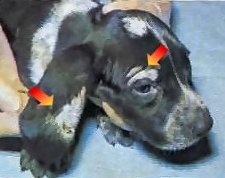Ringworm in dogs is caused by a fungus that causes a circular skin infection. The condition is easily spread between pets and humans. There are many treatment options including shampoos and skin treatments."
Picture of Canine with Ringworm:

Source: Dog Health Guide
Ringworm in dogs is not caused by worms. It is actually a skin disease caused by a plant or when one dog with the disease touches another dog. The fungus lives in hair follicles, causing the hair to break off. It is most common to see the disease on the head, ears, tail and front paws.
The disease looks like a circle on the dog's skin with raised edges. It looks like the hair has been removed in a circle or patch with a pale spot at the center. Common ringworm in dogs symptoms include crusty skin, scaling and some redness. Odd shapes usually mean that multiple lesions joined together. It is easier to see lesions on younger dogs.
The disease usually occurs 10 days after exposure.
Ringworm in Dogs and Humans
Ringworm in dogs can be spread between dogs, cats and humans. Children
are more likely to get the disease than adults. Once someone gets the
fungus, the spores can spread in bedding and blankets. If this is the
case you need to wash exposed garments in bleach and water.
Diagnosis of Ringworm in Dogs
Your Veterinarian can diagnose Ringworm by looking at the skin of your
dog, looking at the skin under a special ultraviolet light (called a
woods light) , or by examining a sample of your dog’s hair using a
special test (fungassay test). Tests using dogs hair usually take 1 to
2 weeks.
Since not all types of ringworm can be detected under the woods light, additional tests are often done.
Ringworm Treatment in Dogs
Ringworm treatment in dogs usually is based on the use of anti-fungal
shampoos or creams. In severe cases oral anti-fungal medication may be
used but this has the potential to cause side-effects. In most healthy
dogs ringworm may resolve spontaneously after several weeks. Treatment
is needed to speed this up due to the risk of infection of humans and
other pets and the discomfort that this condition can cause. Specific
treatment options are as follows:
Skin Treatment – Anti fungal treatments prescribed by your Veterinarian are used for up to 10 days and are applied to the skin. These treatments usually do not work, since most dogs will lick off the cream before it can take effect. An alternative worth considering is Naturasil for Ringworm which is made from a safe homeopathic substance called lipophilic that absorbs into and underneath the skin and hair as soon as it is applied to your dog allowing it to penetrate the ringworm fungus. It works well when combined with Naturasil Herbal Shampoo for Ringworm.
Tablets (Griseofulvin) – These tablwra are given to your dog everyday for 30 days. There has to be fat in your dogs stomach for the pills to be absorbed. You can give your dog a canned dog food or a small amount of fat from meat to ensure that the treatment works. THIS APPROACH SHOULD NOT BE USED DURING EARLY PREGNANCY IN YOUR DOG. Other drugs include griseofulvin, ketoconazole, itraconazole and fluconazole. Itraconazole is preferred because it has fewer side effect, but as all good things, it is more expensive than other treatments.
Baths – 3 baths every other day with an anti-fungal shampoo will help to get the fungus spores off the hairs.
The lather from the shampoo should be left on the dog for 5 minutes.
Follow directions on the bottle.
Shaving – Removing your dogs hair will help rid it of the fungus.
Often, dog ringworm will resolve on its own. When needed, treatments do not work overnight and often take 1 to 2 weeks. You may also see more hair loss before it gets better. If you do not see improvement in 2 weeks, revisit your Veterinarian. If after treatment the Ringworm comes back, it means the original treatment was too short. Preventing the Return of Ringworm in Dogs An infected dog can spread fungus spores throughout the house. These ringworm spores are a risk for reinfection and to humans that live in the home. To prevent reinfection, it is necessary to clean all exposed areas with bleach. Do the same to any fabrics that your dog came in contact with such as blankets or bedding.
References
IVIA - Ringworm Infection in Dogs and Cats
White-Weithers N, Medleau L. Department of Small Animal Medicine, College of Veterinary Medicine, University of Georgia, Athens 30602, USA.